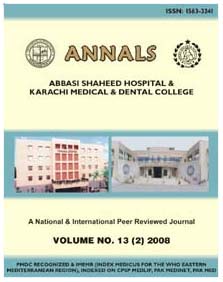
| |
| Home |
| Editorial Staff |
| Instruction to Authors |
| Journal-Issues |
| Policy |
| Copyright |
| ROLE OF TRACHEOSTOMY (EARLY VS LATE) IN INTUBATED
CASES OF NEUROSURGICAL PATIENTS IN SURGICAL
INTENSIVE CARE UNIT (SICU) SETTING
1MASROOR-UD-DIN, 2MOHAMMED AYUB MUSANI, 3YOUSUF KHAMBATY, ABSTRACT Aim: To study the role of early vs. late tracheostomy, in neurosurgical intubated cases admitted in surgical intensive care unit, on recovery from pneumonia during ventilation, length of intensive care unit stay and duration of ventilatory support and weaning. Material and Method: The Study was conducted in the Department of Anaesthesia and Surgical Intensive Care Unit with collaboration of ENT Department, Abbasi Shaheed Hospital, Karachi from Jan 2007-Dec 2008. A retrospective analysis of the case file records of the intubated neurosurgical patients admitted in surgical intensive care unit for whom elective tracheostomy was performed , for prolonged ventilation, was made from 2007-2008 of 50 cases. Early tracheostomy was consider, when it was performed within 3 - 7 days of intubation and late was after that or 8- 14 days. Data collected include the information regarding the patient's name, age, sex, etiology and Glasgow coma score (GCS) on admission, time duration of patients' stay in surgical intensive care unit, time period of weaning from mechanical support and recovery from pneumonia during ventilation ,along with chest x-ray's , culture and sensitivity reports. Depending on the time of tracheostomy performed two groups were made: Group- I in which tracheostomy was performed early within 3-7 days of intubation and Group- II in which tracheostomy were performed after an interval of more than 7 days or 8-14 days (late tracheostomy). Result: For group I the early tracheostomy was done at the median of 4th day vs. that of 10th day for the group II. The number of cases that developed pneumonia in group- I was 45.45 % versus Group- II 54.54%, (odd ratio 0.27). Duration of mechanical ventilation was significant with early tracheostomy (mean, standard deviation) 11.95 days+/-3.14 versus late tracheostomy 21.79 days +/-6.06. Intensive care unit stay was shorter in group- I (mean, standard deviation) 15.09 days +/-3.49 versus in group- II 26.71days +/- 7.00. Recovery from pneumonia was shorter in group- I (mean, standard deviation) 9.0 days +/- 1.63 versus in group- II 14.23 days +/- 1.81. Conclusion: Our study shows that early tracheostomy has a positive role in reducing the risk of pneumonia, because of easier access to lower airway for clearance but not statistically significant, decreased the overall time period of surgical intensive unit stay and patients were weaned off earlier from mechanical support, in comparison to those in which tracheostomy was performed late. Therefore early tracheostomy in selected patients may help in reducing unnecessary resource utilization. Key words: Tracheostomy, intubation, airway management in surgical intensive care (S.I.C.U), early vs. late tracheostomy.
|
For Full text contact to:
|
|
1Anesthesiology Department 2-4ENT Department Abbasi Shaheed Hospital, Karachi
|

Copyright © 2009 Abbbas Shaheed Hospital and Karachi Medical & Dental College.
All rights reserved.
Designed & Developed by: Creative Designers